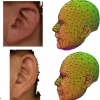Free Online Productivity Tools
i2Speak
i2Symbol
i2OCR
iTex2Img
iWeb2Print
iWeb2Shot
i2Type
iPdf2Split
iPdf2Merge
i2Bopomofo
i2Arabic
i2Style
i2Image
i2PDF
iLatex2Rtf
Sci2ools
CVPR
2010
IEEE
2010
IEEE
3D Morphable Model Construction for Robust Ear and Face Recognition
Recent work suggests that the human ear varies significantly between different subjects and can be used for identification. In principle, therefore, using ears in addition to the face within a recognition system could improve accuracy and robustness, particularly for non-frontal views. The paper describes work that investigates this hypothesis using an approach based on the construction of a 3D morphable model of the head and ear. One issue with creating a model that includes the ear is that existing training datasets contain noise and partial occlusion. Rather than exclude these regions manually, a classifier has been developed which automates this process. When combined with a robust registration algorithm the resulting system enables full head morphable models to be constructed efficiently using less constrained datasets. The algorithm has been evaluated using registration consistency, model coverage and minimalism metrics, which together demonstrate the accuracy of the approach.
| Added | 23 Jun 2010 |
| Updated | 23 Jun 2010 |
| Type | Conference |
| Year | 2010 |
| Where | CVPR |
| Authors | John D. Bustard, Mark S. Nixon |
Comments (0)


